
NASA has asked the US aerospace industry how it would go about "maximizing the long-term efficiency and sustainability" of the Space Launch System rocket and its associated ground systems.
The request comes as NASA and its chief contractor for the rocket, Boeing, are nearing the launch pad after a long, arduous, and expensive development process that has lasted more than a decade. The heavy lift SLS rocket, carrying an Orion space capsule, should finally make its debut during the first half of 2022.
In its request NASA says it would like to fly the SLS rocket for "30 years or more" as a national capability. Moreover, the agency wants the rocket to become a "sustainable and affordable system for moving humans and large cargo payloads to cislunar and deep-space destinations."
NASA sees itself as the "anchor tenant" of the launch system and procuring one crewed flight per year for the next decade or longer. Where appropriate, the agency said, industry will "market" the large launch vehicle to other customers, including the science community and other government and non-government entities.
50 percent price drop
How does one make a system that has been anything but affordable and sustainable into something that is affordable and sustainable? NASA says it wants to transition ownership of rocket production and ground services to the private industry. In return, this private contractor should build and launch the SLS at a substantial savings of 50 percent or more off of the current industry "baseline per flight cost."
Notably, NASA has never publicly stated this baseline flight cost. Ars asked the NASA communications office on Tuesday for this figure, but as of Wednesday morning there has been no response. In 2019, the White House Office of Management and Budget estimated the cost of one SLS launch a year at "over $2 billion." Subsequently NASA did not deny that figure, but it has not been transparent with taxpayers about the rocket's expected costs.
Anyway, NASA now proposes to cut this cost—whatever it is—in half. And it seeks to fly the Space Launch System rocket well into the middle of the 21st century.
This may be theoretically possible, although the agency's history with the large rocket has been shown to be full of wildly over-optimistic assumptions. When the SLS rocket was conceived in 2010 and formally announced in 2011, it was supposed to be launched by the end of 2016 and developed for $10 billion.
Among the rocket's chief architects was then-Florida Senator Bill Nelson, who steered billions of dollars to Kennedy Space Center in his home state for upgraded ground systems equipment to support the rocket. Back in 2011, he proudly said the rocket would be delivered on time and on budget.
“This rocket is coming in at the cost of... not only what we estimated in the NASA Authorization act, but less,” Nelson said at the time. “The cost of the rocket over a five- to six-year period in the NASA authorization bill was to be no more than $11.5 billion. This costs $10 billion for the rocket.” Later, he went further, saying, "If we can't do a rocket for $11.5 billion, we ought to close up shop."
After more than 10 years, and more than $30 billion spent on the rocket and its ground systems, NASA has not closed up shop. Rather, Nelson has ascended to become the space agency's administrator.
Bucking a trend
Beyond the costs of the rocket, there are reasons to have concerns about the idea of flying the Space Launch System rocket for at least three more decades. Virtually the entire global launch industry is either contemplating or moving wholesale toward reusing at least the first stage of large rockets or their engines. SpaceX has led this effort, but other major US launch companies, including Blue Origin, United Launch Alliance, Rocket Lab, Relativity Space, and others, are all incorporating reuse into their business plans. The European, Chinese, Japanese, and Russian space industries are as well.
The Space Launch System, although it is powered by reusable rocket engines that once flew on the space shuttle, is entirely expended after every flight.
Moreover, there is a general sense in the space community that to develop a truly affordable and sustainable exploration plan will require the development of reusable in-space hardware. That is, refuelable upper stages and tugs and in-space assembly, all of which can be launched into orbit on smaller and more affordable rockets. The "launch everything on one stack" approach worked during the brute-force era of the Apollo Moon program, these advocates say, but it is not sustainable. As Apollo's costs were so high, the program was canceled after just six Moon landings.
NASA will hold a virtual "industry day" on its SLS request on November 10 and desires responses from industry by January 27, 2022.
Such an initiative would not be unprecedented. In the early 1990s NASA sought to consolidate its space shuttle operations under a single major contractor. Rockwell International and Lockheed Martin formed a company, United Space Alliance, for this purpose. It operated the shuttle through the end of the program in 2011. It is not at all clear that the space shuttle's operational costs declined during this timeframe.
Article From & Read More ( NASA wants to buy SLS rockets at half price, fly them into the 2050s - Ars Technica )https://ift.tt/2ZsTXMF
Science
No comments:
Post a Comment